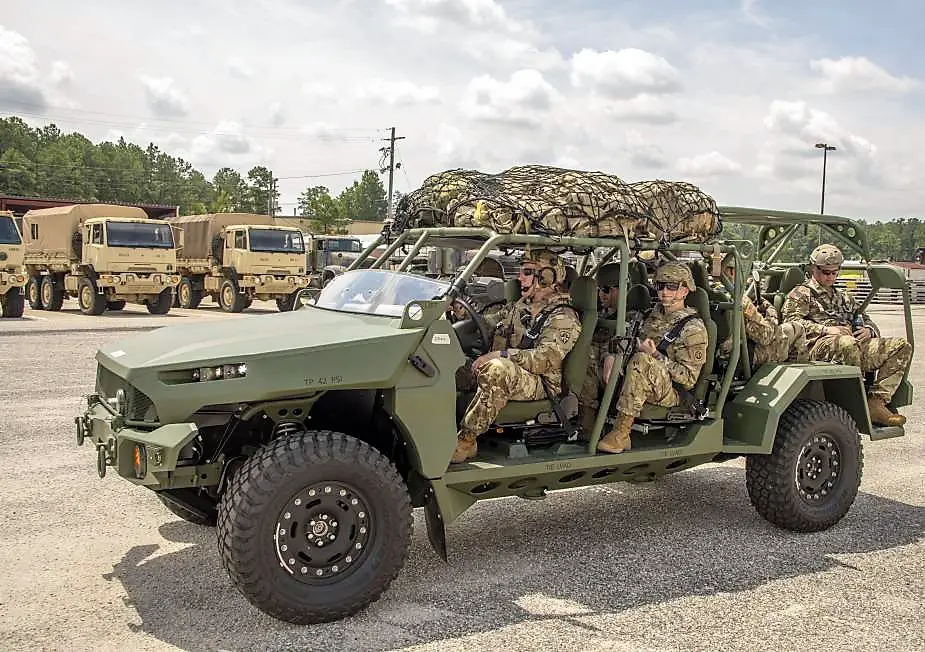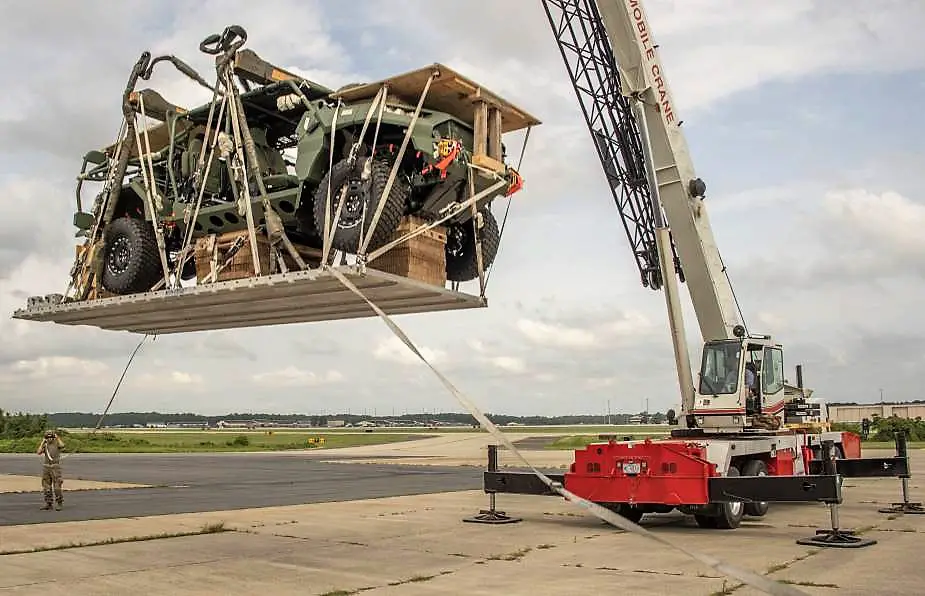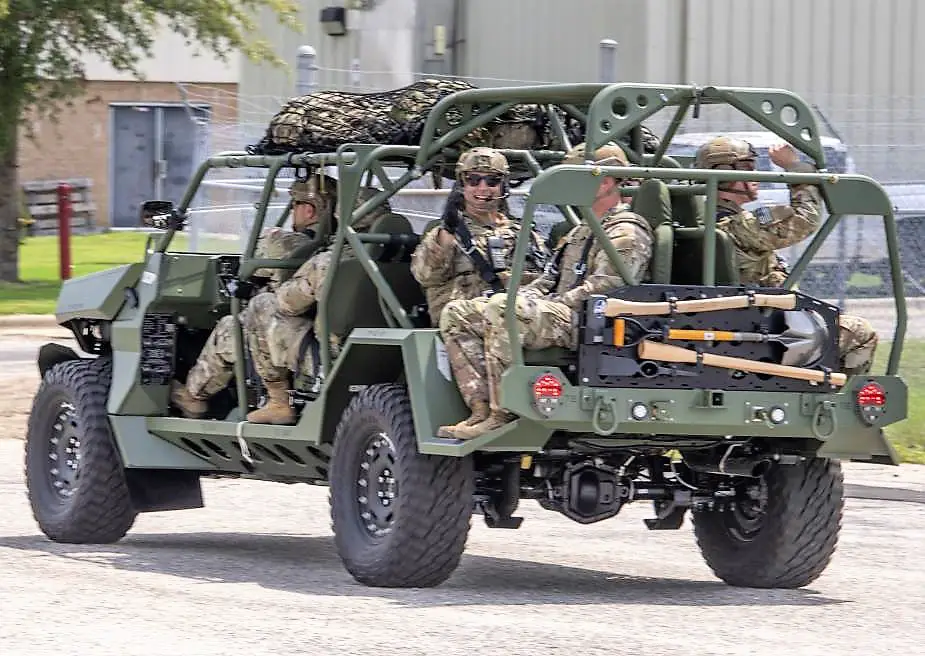U.S. Army airborne equipment testers are working with aerospace engineers on modifying airdrop rigging techniques because of structural and mechanical changes made by the manufacture of the Infantry Squad Vehicle (ISV). Blake Bagby, Military Test Plans Analyst, Airborne and Special Operations Test Directorate, U.S. Army Operational Test Command, reports.
Follow Army Recognition on Google News at this link

Paratroopers assigned to the Airborne and Special Operations Test Directorate prepare to depart for a 50-kilometer road test in a fully loaded Infantry Squad Vehicle (ISV) after modifying airdrop rigging techniques because of structural and mechanical changes made by GM Defense, the ISV’s manufacturer (Picture source: U.S. Army /Michael Zigmond, Photographer, Airborne and Special Operations Test Directorate)
“Testing centered around determining if production representative mode (PRM) ISVs could tolerate the forces experienced during low-velocity airdrop operations (LVAD),” said Lt. Col. Derek Johnson, Chief of Test Division at the Airborne and Special Operations Test Directorate (ABNSOTD).
The ISV is a new concept to allow Army Infantry Brigade Combat Team Soldiers to cover large areas of challenging terrain more quickly and less fatigued by reducing the area usually covered on foot. Infantrymen would also be able to carry enough personal and squad provisions to self-sustain for several days, and the ISV is also transported easily by air assets during air assault and airborne assault missions.
The U.S. Army Combat Capabilities Development Command Soldier Center in Natick, Massachusetts assisted ABNSOTD in modifying the ISV rigging procedures and paperboard honeycomb kit to accommodate changes to the production representative model of the ISV by General Motors Defense. “This capability is required across the range of military operations facing Infantry Brigade Combat Teams conducting crisis response, initial entry, and selected decisive action missions,” said James Cochran (JC), a seasoned Military Test Plans Analyst within ABNSOTD.
Johnson said the changes were deemed necessary after a previous version of the ISV encountered material problems during developmental testing when it was discovered some vehicle components were insufficiently ruggedized for long-term vehicle service. Testing started with a rigging exercise of two PRM ISVs on one standard Type V low-velocity airdrop operations (LVAD) platform and one Dual Row Airdrop System platform. Once rigging solutions and paperboard honeycomb modifications were incorporated into the rigging procedures, both vehicles underwent Simulated Airdrop Impact Testing (SAIT).

The Airborne and Special Operations Test Directorate conducts a Simulated Airdrop Impact Test on an Infantry Squad Vehicle rigged on a Dual Row Airdrop System platform. (Picture source: U.S. Army /Michael Zigmond, Photographer, Airborne and Special Operations Test Directorate)
The two PRM ISVs rigged on airdrop platforms were raised by a crane and free-dropped to simulate the impact velocity experienced during LVAD operations. “During the execution of the SAITs, high-speed video, photography, and instrumentation (accelerometers and impact data recorders) were employed to assess the PRM ISV’s reaction to the forces experienced during LVAD operations,” said Michael Estremera, Electronics Engineer at ABNSOTD. After SAIT, both vehicles were thoroughly inspected by ABNSOTD, General Motors Defense, and the ISV Program Office to see if either ISV had any damage from forces experienced during the simulated drop.

An Infantry Squad Vehicle (ISV) departs Yellow Ramp at Pope Army Airfield, Fort Bragg, North Carolina for a 50-kilometer road test (Picture source: U.S. Army /Michael Zigmond, Photographer, Airborne and Special Operations Test Directorate)
The testing culminated with a 50-kilometer road test, with ABNSOTD personnel operating the PRM ISVs on improved, semi-improved, and un-improved roads as well as off-road routes at various speeds. Following road testing, ABNSOTD, General Motors Defense and ISV Program Office personnel thoroughly inspected both vehicles to assess any damage the vehicles may have sustained. This follow-on testing generated data on the ability of a PRM ISV to withstand the forces experienced during LVAD operations and remain fully mission capable.
The ISV is deployable worldwide by sea, air, and land to support strategic deployment and operational maneuver in accordance with Army and Joint doctrine.

GM Defense displayed its Infantry Squad Vehicle at Eurosatory 2022 defense exhibition in Paris, last June (Picture source: Army Recognition)
The ISV is based on the award-winning Chevrolet Colorado mid-size truck architecture and its ZR2 and ZR2 Bison variants. The underlying architecture is enhanced by a custom occupant and cargo superstructure and features 90 percent commercial of-the-shelf high-performance components, including parts developed and tested by Chevrolet Performance engineering.
Powering the ISV is a 2.8L Duramax diesel engine with a performance tune that produces significantly more power than the Colorado ZR2 known for delivering 186 horsepower and 369 lb-ft of torque. The ISV demonstrates the flexibility and durability of a proven system adapted to robust military requirements. The ISV adapts market-leading advanced automotive technologies to help operators maintain an overmatch advantage against adversaries.
The ISV features upgraded components, many of them commercial of-the-shelf Chevrolet Performance parts, proven in high-demand off-road racing conditions. These include long-travel Multimatic DSSV dampers, jounce shocks, long-travel rear leaf springs, high-angle upper control arms, ball-spline half shafts, steel drive shaft, underbody skid plates, cooling system and 35- inch diameter tires.















